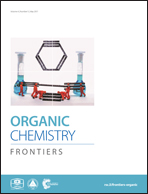6,6′,11,11′-Tetra((triisopropylsilyl)ethynyl)-anti-[2.2](1,4)tetracenophane: a covalently coupled tetracene dimer and its structural, electrochemical, and photophysical characterization†
Abstract
[2.2]-Acenophanes are a class of compounds with two acene units interconnected by two ethano bridges. Due to the short bridges, the two acene subunits are in close proximity and can result in a modification of properties compared to the monomeric acene. We describe the synthesis of the first example of a [2.2](1,4)tetracenophane that is modified by four (triisopropylsilyl)ethynyl substituents and its characterization by a number of techniques including single crystal X-ray crystallography. The tetracene moieties are found to be essentially parallel to each other in the molecule. The packing is characterized by the formation of a staircase arrangement with a weak overlap between individual tetracenophane molecules. Optical spectroscopy and electrochemical investigations indicate that the two tetracene moieties of the tetracenophane communicate more than the individual pentacene units in the larger pentacenophane.
tetracenophane: a covalently coupled tetracene dimer and its structural, electrochemical, and photophysical characterization](/en/Image/Get?imageInfo.ImageType=GA&imageInfo.ImageIdentifier.ManuscriptID=C7QO00117G&imageInfo.ImageIdentifier.Year=2017)
- This article is part of the themed collection: Novel π-electron molecular scaffolds

 Please wait while we load your content...
Please wait while we load your content...